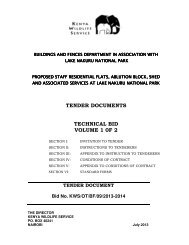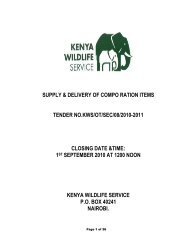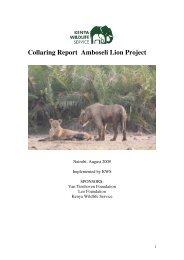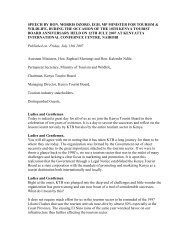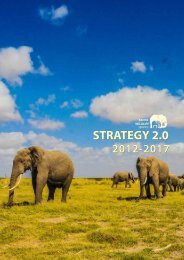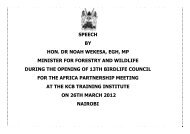Conservation and Management Strategy for the Elephant in Kenya
Conservation and Management Strategy for the Elephant in Kenya
Conservation and Management Strategy for the Elephant in Kenya
You also want an ePaper? Increase the reach of your titles
YUMPU automatically turns print PDFs into web optimized ePapers that Google loves.
CONSERVATION AND MANAGEMENT STRATEGY FOR THE ELEPHANT IN KENYA 33<br />
2.2 Structure of this strategic document<br />
The logical structure of this <strong>Kenya</strong>n <strong>Elephant</strong> <strong>Conservation</strong> <strong>Strategy</strong> can be seen from <strong>the</strong> ‘Plan-at-a-glance’ (Figure 1)<br />
<strong>in</strong> <strong>the</strong> executive summary.<br />
The Vision sets out <strong>the</strong> desired situation to be achieved <strong>in</strong> <strong>the</strong> future. As such it represents a long-term goal.<br />
This strategy has a 10-year time horizon, <strong>and</strong> sets measurable short-term <strong>Conservation</strong> Goals. By achiev<strong>in</strong>g <strong>the</strong>se<br />
goals, progress towards achiev<strong>in</strong>g <strong>the</strong> long-term Vision will have been made. The strategy identifies a<br />
number of Key Strategic Objectives namely:<br />
1. Protection<br />
2. Population expansion <strong>and</strong> habitat ma<strong>in</strong>tenance<br />
3. Research <strong>and</strong> monitor<strong>in</strong>g <strong>for</strong> management<br />
4. Human elephant conflict<br />
5. Incentives<br />
6. Capacity<br />
7. Coord<strong>in</strong>ation <strong>and</strong> support<br />
Achiev<strong>in</strong>g all of <strong>the</strong>se Key Strategic Objectives is essential to successfully meet<strong>in</strong>g <strong>the</strong> short-term <strong>Conservation</strong> Goals.<br />
In <strong>the</strong> body of <strong>the</strong> <strong>Strategy</strong>, a brief Rationale section is given <strong>for</strong> each Key Strategic Objective expla<strong>in</strong><strong>in</strong>g why <strong>the</strong><br />
particular Key Strategic Objective is important to meet<strong>in</strong>g <strong>the</strong> <strong>Conservation</strong> Goals.<br />
The <strong>Strategy</strong> also lists a number of Objective Targets which are measurable steps that describe what needs to be<br />
accomplished to meet each Key Strategic Objective. These Objective Targets should be SMART (i.e. Specific,<br />
Measurable, Achievable, Realistic <strong>and</strong> Time-based).<br />
Each Objective Target is also specified with a list of Actions which need to be implemented <strong>in</strong> order to achieve <strong>the</strong><br />
particular target. In addition, Indicators of Success are def<strong>in</strong>ed <strong>for</strong> each Action which help to def<strong>in</strong>e what each<br />
Action is <strong>in</strong>tended to achieve, <strong>and</strong> to determ<strong>in</strong>e when <strong>the</strong> Action has been per<strong>for</strong>med successfully by those<br />
<strong>in</strong>dividuals or organisation (Actors) responsible <strong>for</strong> <strong>the</strong> Actions.<br />
[ RIGHT ]<br />
Plate 28.<br />
Farmers benefit from honey<br />
from protective Beehive Fences<br />
Lucy K<strong>in</strong>g, Save <strong>the</strong> <strong>Elephant</strong>s




